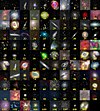NGC 5005
| Galaxy NGC 5005 |
|
|---|---|

|
|
| Photo from the Hubble Space Telescope | |
| AladinLite | |
| Constellation | Hunting dogs |
|
Position equinox : J2000.0 , epoch : J2000.0 |
|
| Right ascension | 13 h 10 m 56.2 s |
| declination | + 37 ° 03 ′ 33 ″ |
| Appearance | |
| Morphological type | SAB (rs) bc / Sy2 / LINER |
| Brightness (visual) | 9.8 likes |
| Brightness (B-band) | 10.6 mag |
| Angular expansion | 5.8 ′ × 2.9 ′ |
| Position angle | 65 ° |
| Surface brightness | 12.7 mag / arcmin² |
| Physical data | |
| Affiliation | NGC 5033 group NGC 5005 group LGG 334 |
| Redshift | 0.003156 ± 0.000017 |
| Radial velocity | (946 ± 5) km / s |
|
Stroke distance v rad / H 0 |
(44 ± 3) x 10 6 ly (13.6 ± 1.0) Mpc |
| history | |
| discovery | Wilhelm Herschel |
| Discovery date | May 1, 1785 |
| Catalog names | |
| NGC 5005 • UGC 8256 • PGC 45749 • CGCG 189-035 • MCG + 06-29-052 • IRAS 13086 + 3719 • 2MASX J13105631 + 3703321 • GC 3437 • H I 96 • h 1547 • NVSS J131056 + 370332 • LDCE 867 NED131 | |
NGC 5005 is a bar-spiral galaxy with an active nucleus of the Hubble-type SBbc in the constellation Hounds in the northern sky . It is estimated to be 44 million million light years from the Milky Way and about 75,000 light years in diameter. Together with NGC 5033 , it forms a pair that weakly influences each other.
In the same area of the sky are u. a. the galaxies NGC 5002 , NGC 5014 , IC 4207 .
The Type Ia supernova SN 1996ai was observed here.
The object was discovered by Wilhelm Herschel on May 1, 1785 .
Web links
Commons : NGC 5005 - collection of images, videos, and audio files

